The Article
R-N602 From Yamaha: On The Receiving End
19th October 2016
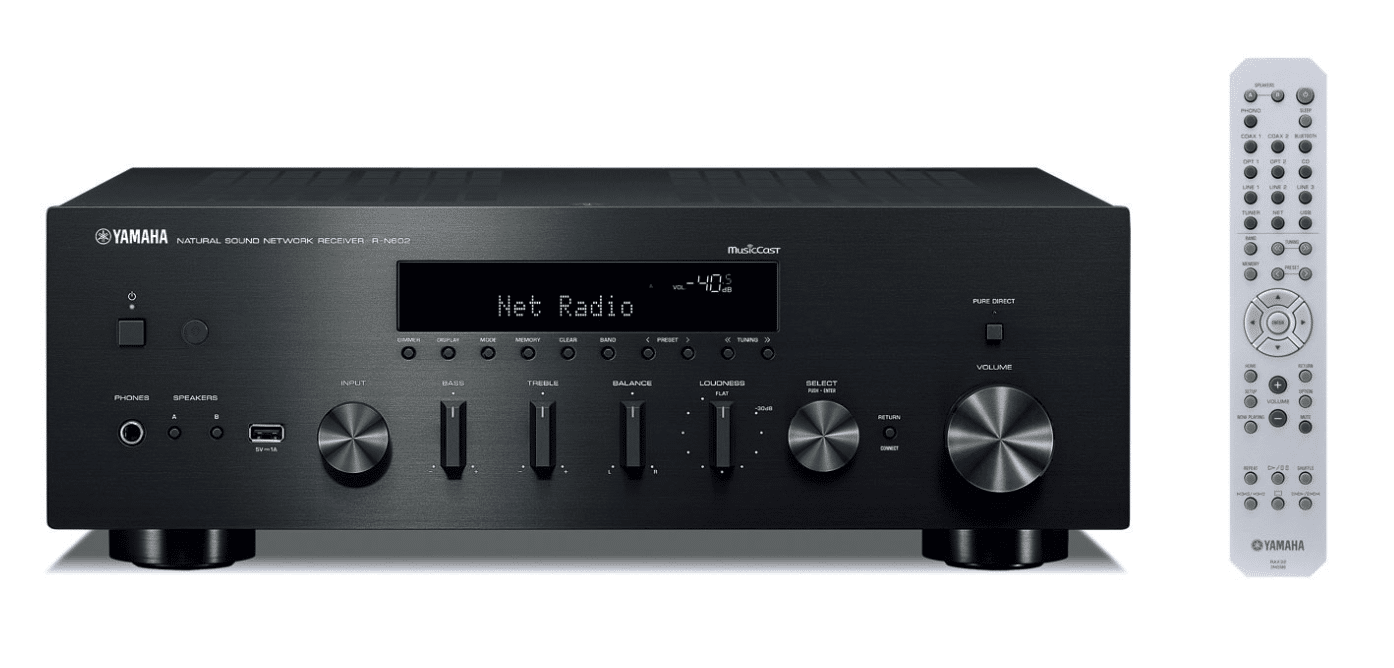
Sporting a retro amplifier design but packing in numerous digital and networking facilities, Paul Rigby reviews Yamaha’s budget receiver, the R-N602
It’s big, it’s meaty, it’s got buttons and switches and knobs and it’s shiny (silver) or its so dark that light falls into it (black, what else?) and you could put caterpillar tracks underneath it and invade a small neighbouring country without a shot being fired because the populous would run away from it, hands in the air, screaming hysterically. This is Yamaha going back to its 70s roots. You don’t look horizontally at the R-N602, you walk up to it, pause, then you lift your head slowly and see if you can make out the summit…somewhere in the clouds.
You also don’t turn on a 115W R-N602 via the on/off button, you send it a letter of introduction and then wait for permission.
While doing so, you can note that the R-N602 is designed to be used as part of Yamaha’s MusicCast network audio system that allows you to use all your MusicCast products together or separately, controlled from one app which, of course, also means popular streaming services (where applicable in supporting countries) such as vTuner internet radio, Pandora, Rhapsody, Spotify, SiriusXM, Napster and Juke. On the networking subject, the ‘Yammie’ also supports AirPlay, DLNA plus Digital Blocking (an iPod’s direct signal is sought feeding the Yamaha’s own DAC). An ECO mode reduces power by 20%, you have access to Bluetooth, Wi-Fi plus a Pure Direct button to bypass the majority of the amp’s electronics to enhance sound quality.
In terms of files support, the Yamaha supports 5.6MHz DSD and AIFF 24bit/192kHz, WAV/FLAC 24bit/192kHz plus the usual suspects via a Burr Brown DAC. There’s also a FM/AM tuner, speaker terminals for two systems and, oh yes, the ability to plug a turntable directly into the box because you get a phono amp, built-in. More about that later. Other sockets around the back, apart from plentiful source RCA-based connectors, include two opticals, two coaxial, a wireless port for a screw-in aerial plus the ability to connect Ethernet and a subwoofer.
IN USE
It’s bulky, retro and clunky. In fact, the hefty and expansive Yamaha glories in its retro clunkiness. It comes at you, arms open with that certain ‘look at me!’ exclamation as it displays hulking great knobs that control those old classic controls: treble, bass, balance and, don’t forget that old favourite, ‘loudness’, sitting next to more modern additions such as the USB source socket. Some might question the inclusion of such controls and I would agree that the treble/bass/balance/loudness quartet are worse than useless. That said, the Pure Direct removes any criticism because it allows the sound signal to skip right past them. Hence, their inclusion could be seen as ‘a bit of fun’. In these design terms and for this price…sure. Why not? The target audience, many of which will be maturing beginners with hi-fi experience that relates to their parents old system, may even see the inclusion of such controls as a comforting familiarity.
SOUND QUALITY
I began by spinning Buffalo Springfield’s For what It’s Worth (1966) on the Leema Elements CD Player. Three things hit me immediately. Firstly, the bass was very strong and punchy. Yamaha likes its lower frequencies and the performance here maintains the house sound which means that this track offered excellent bass force and foundation. The song was driven throughout with a strong rhythmic drive that gave the track an enhanced sense of pace.
There was a lack of engagement, though. By that, I means that the soundstage did sound a little stark. It was almost as if the guys played in a studio that was, by day, an operating theatre. There was a slight lack of soul and musicality in the R-N602s presentation so that the drums never really connected with the guitars or the emotional vocals. Then I noticed that the Pure Direct button had not been engaged. Turning this feature on bypassed much of the amp to provide a more direct sonic pathway. This improved the sound quality immeasurably, giving the vocals a more, well, human quality with delicate textures from the vocal chords more in evident while the guitars offered greater grit and involvement. Despite the good news, though, a certain analytical edge remained but the effect was greatly reduced in Pure Direct mode.
The sense of clarity from the upper midrange and treble enhanced the tonality of the music while there was tremendous instrumental separation around the soundstage so the band sounded relaxed and at ease with their playing. There was never any sense of tension. The air and space exhibited also gave the frequencies time to decay properly which enhanced the performance of these organic instruments, increasing detail.
These days, I only tend to handle MP3 files with rubber gloves and a pair of forceps but playing Kylie Minogue’s All the Lovers from her Abbey Road Sessions album in this execrable sound format sounded half decent via my Apple iPhone 6S over Bluetooth. There was plenty of room to be had while midrange and bass existed in an admirably balanced manner. Strings were thin and nasty, yes while Minogue’s vocals made her sound like she had a pinched face (I imagined her as the green-faced witch in the film, The Wizard of Oz, MP3s made Kylie sound just like that) but, even given the lack of musical data, the Yamaha performed tremendously to give you the best performance it could. As if the amp was exclaiming, “Look, guv, I haven’t got much to work with here…but this is the best I could do.” I’ve heard a lot worse, even via equipment price higher than this receiver.
Using a USB stick, I played the DSD version of the Allegro for Bach’s Concerto for Harpsichord, Flute and Violin via the front loading USB port and was pleased to hear the relatively spacious digital performance of the R-N602 continue here. Strings and the wind section did sound a little thin and slightly forced, though, even at this high resolution. The performance basically allied itself to the earlier CD tests, in this respect. That said, there was much to admire with the informative nature of the track giving this textured and detail arrangement time to manoeuvre while allowing complex instruments such as the harpsichord a chance to express itself.
Up until now, we had a reasonable digital power house that looked great on paper but offered no more than a ‘credible’ performance in reality.
Then something wonderful happened.
I wanted to test the internal phono amp of the Yamaha. At this price, it is more likely that users will be utilising the internal module and not spending out for an external phono amplifier. Pushing an analogue signal through this unit was fascinating because the results were surprisingly good. The slightly sparse nature of the presentation combined with the epic quality of the phono amp and the warmth of the basic vinyl signal to provide a big, bold, open and grand musical return. Trumpets sounded clear and brassy without a hint of stridency or brightness, saxophones were reedy and emotive, vocals offered a precision and enhanced diction and bass was firm, fast and informative. This heady mixture was quite a sonic revelation for the price!
CONCLUSION
The Yamaha R-N602 offers plenty of value for the money and a wide array of features with an appealing retro design. Despite the slightly constricted digital response in CD and general digital file terms, I was blown away by the analogue play and can whole heartily recommend this amplifier if you are looking for an amplifier to act as the heart to your vinyl hi-fi system.
In fact, I would go further than that and advise you not to look at this box as a multimedia receiver at all. Me? I would not buy it for its digital features. I would turn the feature list on its head. I would see this product as the amp section of a new vinyl system with plenty of bonus digital features added on because even if you saw the Yamaha as nothing else but a vinyl-based amplifier, it would still be good value. Anyone looking to set up a budget vinyl system really needs to place this box on their demo list and pronto.
YAMAHA R-N602 RECEIVER
Price: £339
Web: uk.yamaha.com/en
Tel: 01908 366700
For more specifications, click HERE
GOOD: Pure Direct mode engaged, open and natural phono output, feature count, Bluetooth, price
BAD: Pure Direct Mode disengaged, digital playback
RATING: 7
REFERENCE SYSTEM
Rega RP3 turntable
Leema Elements CD Player
Rega Brio-R amplifier
Spender S3/5R2 speakers
Chord Shawline cables

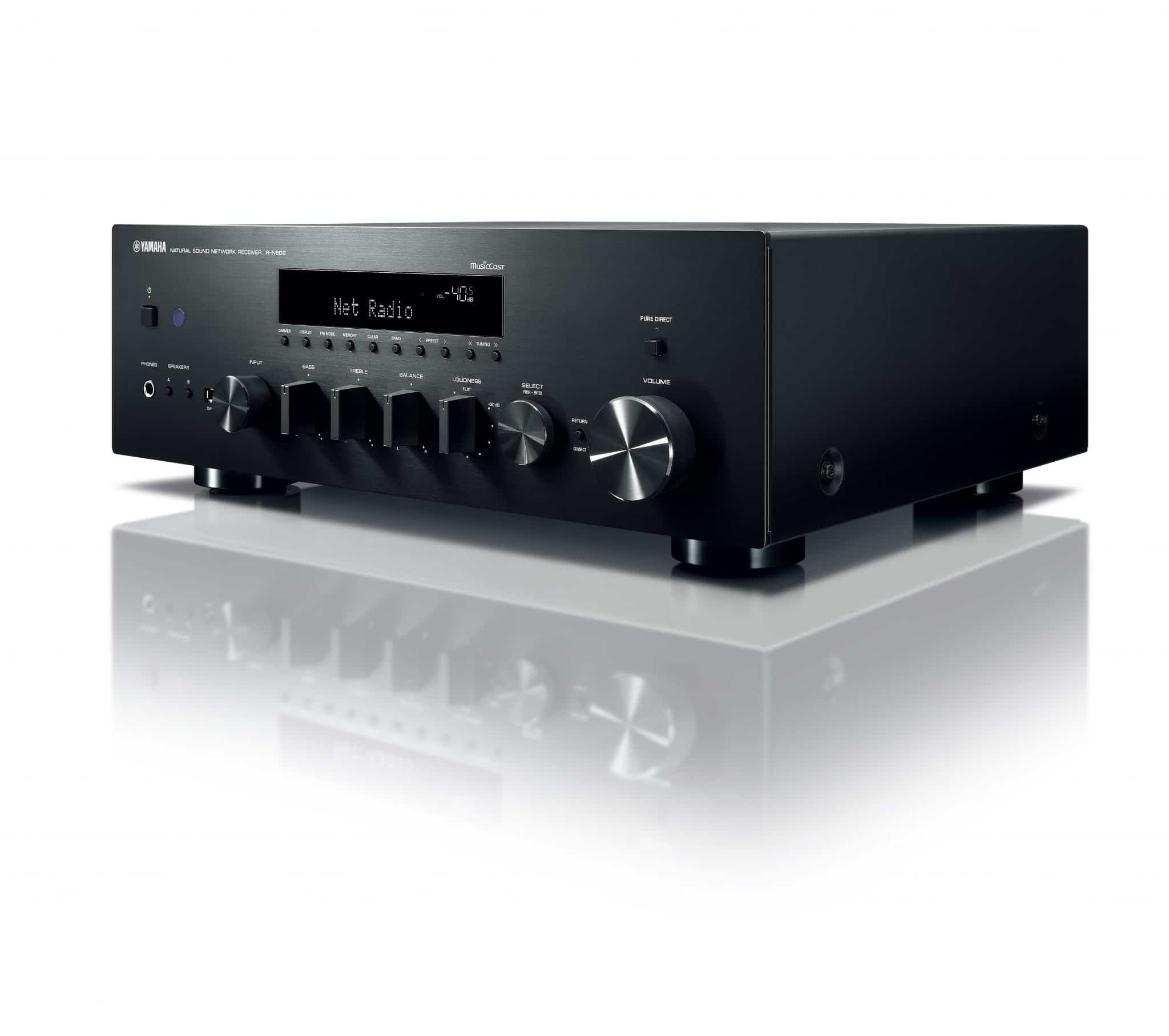
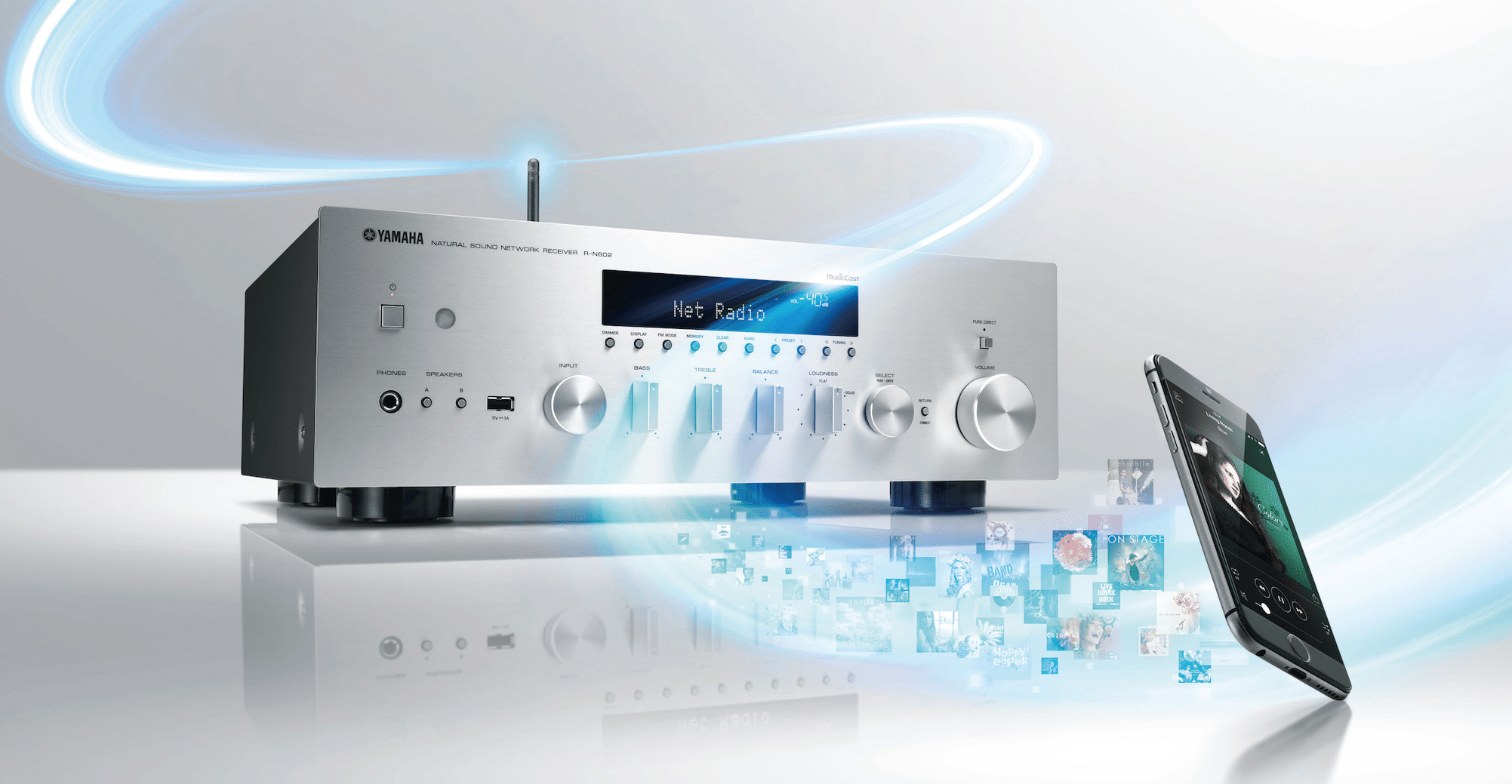
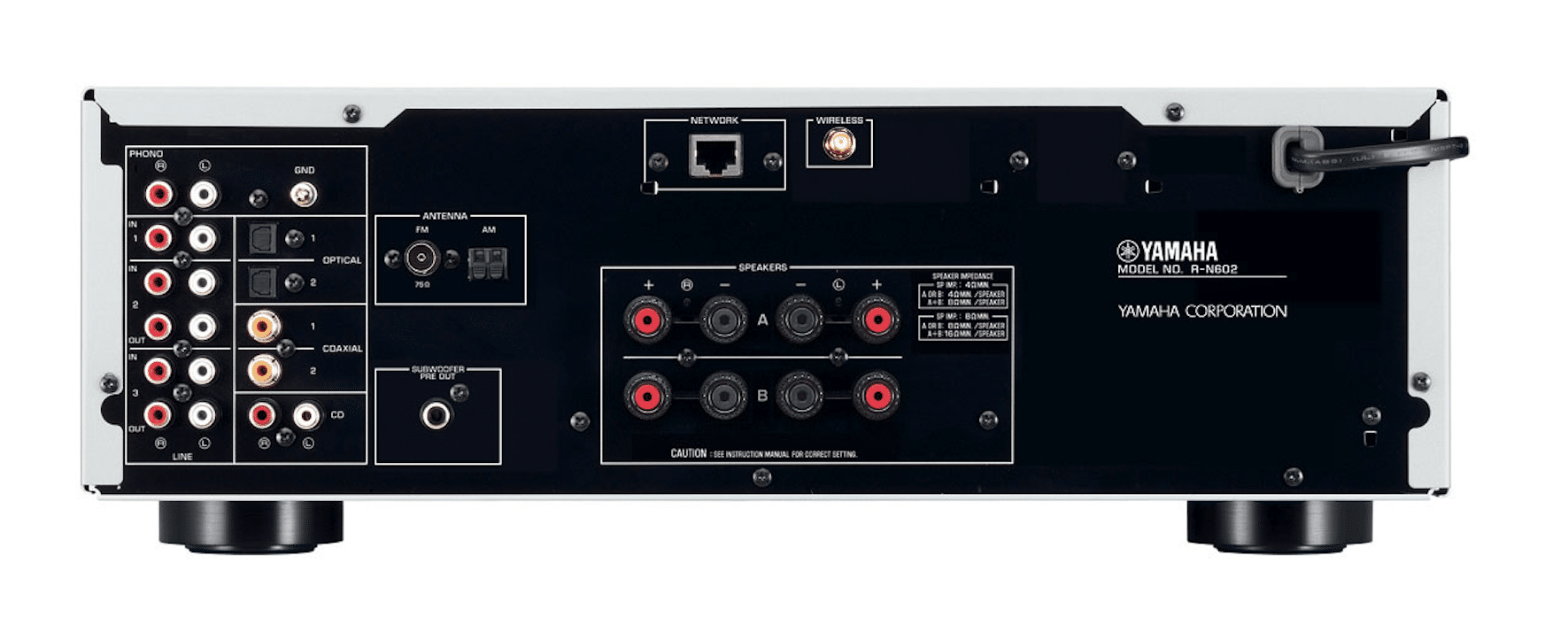
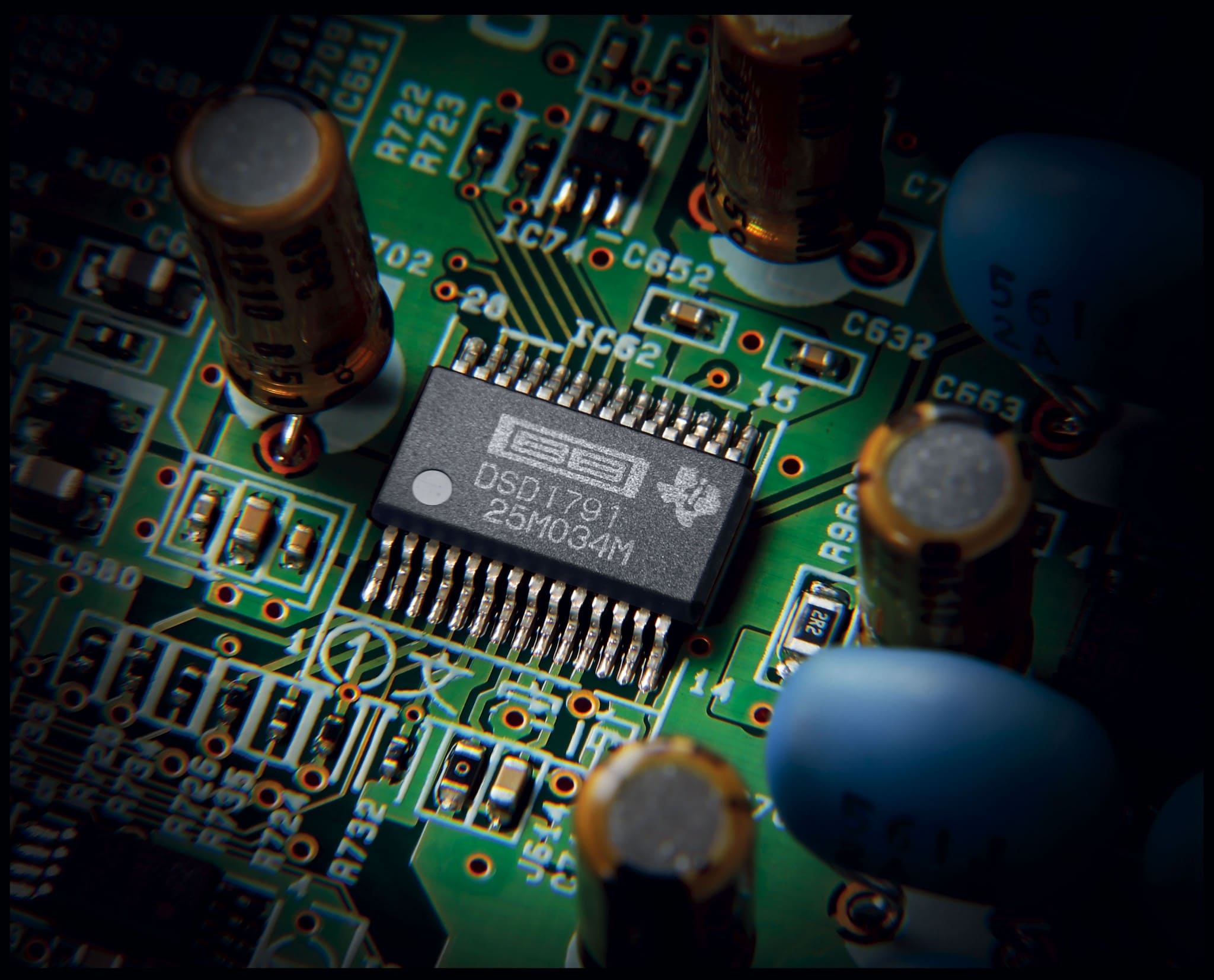
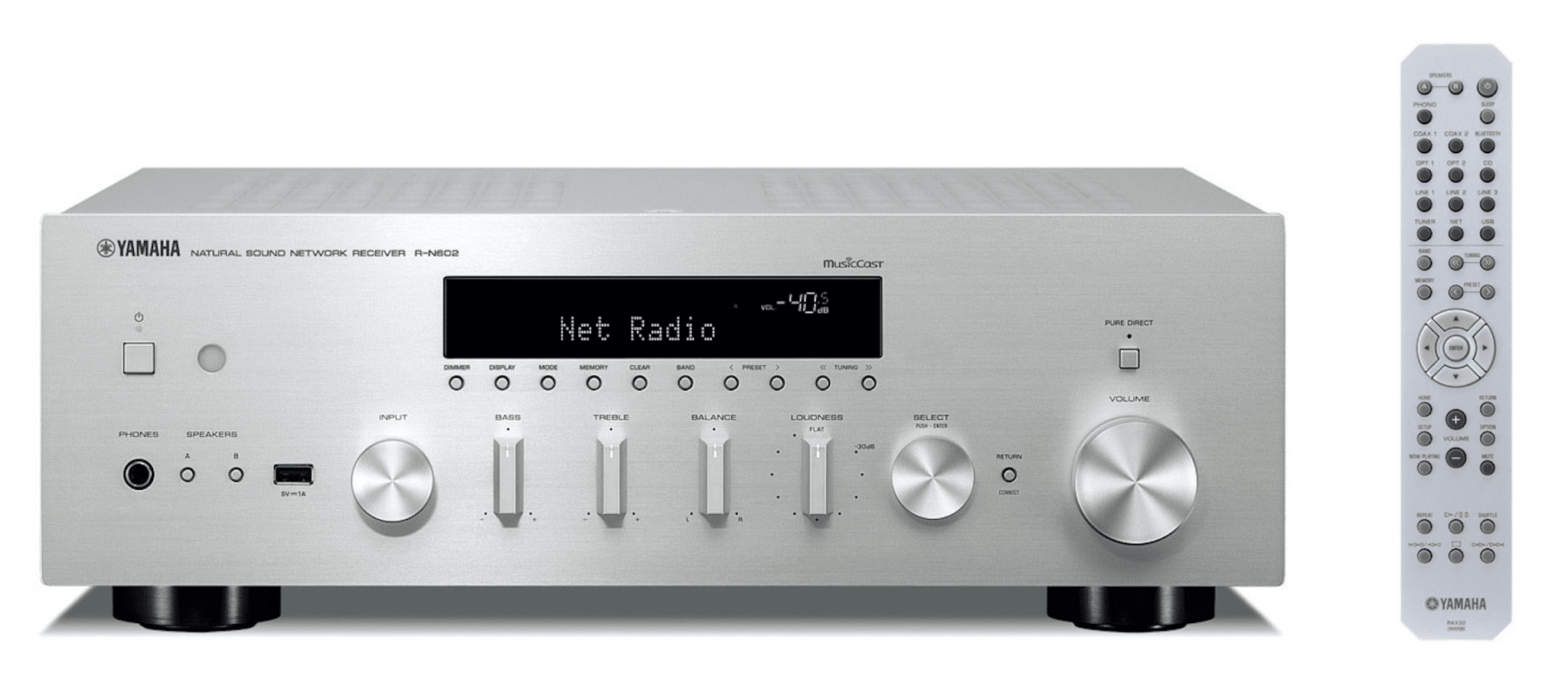


I have a Yamaha HTR-3066 receiver, which is part of a Home Theatre in a box package. Can you connect it the RN-602, as I thinking of pur hasing one.
Double check with your dealer but I would say no. The 3066 has a Pre Out socket but that’s aimed at a subwoofer. Not sure of the 602 would be compatible.
Hi Paul,
Would I be able to plug in Bose 901 Series VI equalizer into any one of the audio input/output RCA jacks and achieve results i.e. Bose recommends plugging in to Tape Monitor jacks (or failing that, preamp/amp jacks) back in the day i.e. 30 years ago?
Hi Bob
This from Steve Wells at Yamaha’s Technical Dept, “I‚Äôm pretty certain that you cannot connect an equalizer to more modern equipment like the RN602, as you would need a tape monitor switch to enable you to select the equalized audio back into the amp/receiver, you could have say one source Equalized (if you daisy chain via the EQ) but I guess the customer would want all inputs into the RN-602 to have the benefit of the EQ, again as the RN602 has no old fashioned in/out like older amps, you don‚Äôt have this option either. I will check with the designers of this unit to confirm my suspicions, but I think this is a no, pretty near all modern units are not built to support older legacy kit like EQ‚Äôs unfortunately.”
Hope this helps you.
Dear Paul Rigby,
I bought 3 Yamaha r-n602 and 2 r-n803, but I don’t want to use Music Cast, Bluetooth, Spotfy, nothing. I’ve the Yamaha R-S700 and I’m very happy with it, using 4 JBL Tower Speakers all the time for 10 years or so. I’ve two Pionner sx-1980, but it’s too powerfull to move my JBL tower speakers 250 watts rms 8 ohms… How can I use the same 4 JBL in my 5 new Yamaha Stereo Receivers, without any trouble with apps or cellulars or any modern things???
How do I get permission to use 115 watts per channel rms in 8 ohms? From Yamaha?
Or there is something that I can get more power from Yamaha r-n602 in 8 ohms, and from Yamaha r-n803?
If I only power my Yamahas r-n602 and r-n803 the impedance will be 8 ohms immediately or I have to do the “trick” to turn it off, press another key, and etc.
Hi Paul, great review!
I have the RN500, which is quite similar. The audio is what I’d expect, but there is one annoying thing about it: I have a lot of music on a network drive (around 2TB) , and it takes a very long time for the list of albums to load on the app. I’m guessing that the RN500 is not powerful enough to index it in a shorter time.
I’m wondering if there is any recommended solution to this problem.
Thanks.
Let me have a chat with Yamaha about this one Assaf and get back to you…
This is from Yamaha’s tech dept, Assaf: “This can be down quite a few devices, this can be down to the router, NAS drive or the software used, a quick test is to try another make of music server software, does this seem any quicker, also having the NAS directly connected to the router rather than a network switch. But unfortunately there is nothing that can be done to the Yamaha, sorry this was not the answer your reader was looking for.”
Hey. Is it possible to bi amp on this receiver?
Hmmm, looking at the rear, I would say no. Unless anyone reading this has rigged up an alternative that works?
Yes, it is possible when you turn on the A and B channel by the same time; I have this function on my NS-F350 speakers and it sounds exquisite.
Hullo there. I do have yamaha’s rn-602 receiver for over a year now and I am pretty much pleased with it, as I can use it as a tuner (fm/am band), as a network receiver and I can also connect to my nas and play the music files I have stored there. But what I really want to ask you is that, do you think I could connect to the rn-602 a digital sound processor (technics sh-ge90) and through that dsp a cassette deck (sony’s tc-ka6es)? Or maby, it would be wiser to put another amplifier between them, one that has the specific indication “rec in-out”?
Hi Gousios
I talked to Yamaha about your questions and here is what they said. Hope it help, “The R-N602 does have the Rec outs, that can be connected to another amplifier, but this cannot be routed back in for all sources via a GEQ, so it would be best idea would be to connect an amplifier (which has the ability to be connected to a GEQ i.e. main in and out) then use the REC out on the Yamaha as the source to the second amplifier, unfortunately newer products like the R-N, do not have the in/out for a GEQ or a tape monitor switch to enable connectivity to legacy equipment.”
didn’t understand how to increase the power of Yamaha r-n602 to 115 watts rms into 8 ohms. How you said (written above). You also don‚Äôt turn on a 115W R-N602 via the on/off button, you send it a letter of introduction and then wait for permission. Because, if I get 115 watts rms into 8 ohms and using 4 JBL s-312 I’ll not need an amplifier. And I never get an answer about an amplifier to Yamaha r-n602. For example, Parasound 2250 v.2 (it’s a stereo amplifier, and different than Yamaha r-n602, this amplifier has only a way for 2 speakers, not 4 speakers. I thought that an external amplifier only will increase the power (the volume of sound) of a Stereo Receiver. I don’t want to miss my all control of Yamaha r-n602 connected with 4 speakers. May you, please, or another people here, explain my questions, because I’m trying to get those information for 4 months, and nothing.
I have asked Yamaha for help on this one but please be patient. If they get time, I’m sure they will provide assistance.
You’re in luck – a very kind gentlemen at Yamaha had a few moments for you. Here’s what he said, “So let me try to lay some facts on the table first. Below are the real world power specifications of the amps in question.
Yamaha R-N602 – minimum RMS output power (20Hz – 20kHz, 0.04% THD, 8ohms, 2ch driven) 80W
Yamaha R-N802 Рminimum RMS output power (20Hz – 20kHz, 0.019% THD, 8ohms, 2ch driven) 100W
It is not possible to get either amp to drive 2 speakers at 115W, 20Hz – 20kHz, 8 ohms, with a respectable level of THD. So connecting 4 speakers will also not be possible and produce an even lower power output figure if measured.
The quoted 115W figure found in the manual has been measured with a single speaker attached, at 1 frequency (1kHz), with 10% THD, 8ohms. Its very difficult to draw much meaning from this, so I would strongly suggest looking at the minimum RMS output power figures as stated above.
Using an external power amplifier to drive bigger or more speakers is a good option, however neither the R-N602 or R-N803 has a stereo pre out connection to allow this upgrade.
Pre outs currently start to appear on the R-N2000A from our Stereo receivers, A-S1200 from our Integrated amplifiers and RX-V6A from our AV Receivers.
Running 4 JBL s-312 at the same time is perfectly safe to do, on either R-N602 or 803 when selecting the 4ohm (SP IMP.) speaker impedance setting”
Hi Paul,
Your review has the last word in my decision: I should buy it :). And I want to use it with Dynavoice Dm-6 speakers. It’s ok? Should I take in consideration another model?
Now, in my country there aren’t any internet music services like Pandora or Spotify.
Buy, using network, can I search over the internet online music using generic? Like Jazz or rock…?
Thx,
Dan
Hi Dan – sorry for the reply delay, just moved house! I’d prefer the Q Acoustics 3020s speakers, a but cheaper and sounds better! Result! https://theaudiophileman.com/q-acoustics-3020-bookshelf-speakers-first-q/
The Yamaha also includes Internet radio – so you will have access to worldwide ‘streaming’ of all genres via this source.
Hi Paul,
Thx for your reply.
I will go and listen Q Acoustics. They are at half price as Dynavoice 🙂
Hi Paul,
Still nothing change from my side regarding this aquisition :(. Still looking for best combination between this amplifier and speakers that fits my budget – 800GPB.
This amplifier is 440GPB. So I need to find best standfloor or shelf for 350GPB for my ~40 square meters room.
And I have these options – if you don’t mind to take a look:
https://www.avstore.ro/filters/boxe/tip___boxe-de-podea__boxe-de-raft—p2/?sort=price_asc&price=299_2099
Or something from Indiana Line
INDIANA LINE NOTA 550 X
INDIANA LINE TESI 262
Thx and sorry for bother you 🙂
I’m a bit lost, Dan – last time we chatted I assumed you were going to listen to Dali and Wharfedale speakers? The Triangles are possibly too good for the Yamaha.
I was. But i’m not happy with them.
Hi Dan – what’s your source?
Hi Paul,
My sorces:FMTuner, TV, network (Spotify, internet Radio), USB
Hi Dan – and are all of these direct from the Yamaha?
Hi Paul,
Yes. Its’n correct? That is the reason I choose Yamaha: I have optic, network, USB as input..
Hi Dan – ok, I’m with you now. Do you connect other sources to the Yamaha through the digital ports? If so, what?
You say you’re having problems finding the correct speakers. What exactly is the issue?
The issue is to find the best speakers for it in my budget.
The Q Acoustics and Dali speakers are excellent speakers for your budget but you rejected them. Hence, my wish to target the reason.
Hi Paul,
I rejected Dali & Wharfedale.
I wil listen Q Acoustics 3020i and 2010 and also 3050
OK, Dan – good luck! 🙂
Paul,
What about Dali Zensor 3?
I ask you because there isn’t any place where I can listen them all 🙂
Where they have Dynavoice don’t have Q Acoustics 3020.
Thx,
Yes, Dan, the Dali option is a good one.
Hi Paul,
Thx. You are so understanding and patient!
Let’s rezume:
1. Q Acoustics 3020
2. Dali Zensor 3
3. Dynavoice
Thx again Paul.
Hi again 🙂
One more thing: what about Monitor Audio Bronze 2?
I saw that they have 8Ω, the others have 6Ω.
Yamaha said: High Dynamic Power/Channel (8/6/4/2 ohms) – 105 / 125 / 150 / 178 W
And
Power Handling R.M.S. – 100W
Recommended Amplifier Requirements – 30-100W
That means that they are supported?
Thx again Paul
Dan
Yes, the Monitors are another good option. I’d recommend a demo, if possible because each speaker type will offer minor sound bias types which may tickle your ears (or not). 8 Ohms is fine but the amp works a bit harder to reach the same volume.
Thx PAul,
I will schedule a demo with Dali Zensor and also I will try Wharfedale Diamond 220
Hi Paul,
What about Triangle Esprit Comete Ex?
Thx,
dan
Yes, good design but beware that the punchy presentation can be a little wearing on the ear over time for some.
Hi, Paul!
Some weeks ago I bought this receiver and a pair of DALI Zensor 3. Low frequencies was not enough for me (my room is 4×4 meters) and I bought subwoofer DALI Sub E-9 F. At first I connected subwoofer at LFE but later I testet connect to L channel Line Input (crossover potentiometer put on 80 Hz) and in this connection subwoofer sounds better. May be You know frequency cut on Subwoofer Output on Yamaha R-N602?
Thx!
Let me confirm that with Yamaha – I’ll get back to you ASAP.
If You connect with Yamaha, may be You can also ask about Speakers Output frequency? On my old reciever Panasonic I can set up “small” or “large” speakers, but in this receiver I cannot find nothing similar!
I’ll do my best 🙂
Hi Gints – this from Yamaha “To answer the second question, AV receivers have ability to set speakers to small or large, Hi-fi products normally do not have this function, only our R-N803D has this function, so no speaker size function on the 602. The crossover on our R-N602 is set to 90Hz.”
Hi, Paul!
Thank you very much!
Hello I see this unit is available in silver, bit I find it. Where can I purchase it in silver. I’m in NY USA
Tough one because Yamaha USA appears to offer the black version only. You might try contacting your local dealer here: https://www.yamaha.com/paragon/dealerlocator/?pid=0028.2801.449473 and asking them if they can source a silver version for you.